| Title | Image | Summary of text |
|---|---|---|
| Goeree - Natural Design - Page 51 |  | The text discusses the variations in beauty in human figures across different nations and cultures, examining how environmental factors and cultural practices contribute to these differences. It highlights how certain groups, like the Jews, maintain distinct characteristics by not mixing with others, and compares aesthetic traits among German, English, French, Italian, and Spanish people. It concludes that such diversity in beauty cannot be confined to strict or absolute rules in art. |
| Goeree - Natural Design - Page 52 |  | The text discusses the idea that painters should continuously observe and internalize the beauty they see to effectively replicate and portray it in their works. The emphasis is placed on understanding the proportions and unity of different parts to convey beauty as seen in human figures. It highlights how this practice not only guides painters in imitation but also helps them exercise imagination when direct models are unavailable. |
| Goeree - Natural Design - Page 53 |  | The text discusses the concept of beauty in art, emphasizing the importance of imagination over copying real-life models. It refers to the practices of ancient artists like Phidias and Zeuxis, who relied on ideals and composite images to depict beauty. The passage also highlights the challenge and artistry required to synthesize beauty from multiple sources. |
| Goeree - Natural Design - Page 54 |  | The text discusses the concept of beauty in art, with references to mythological figures like Venus. It highlights how ancient artists endeavored to capture this beauty in their sculptures and paintings by comparing them to the natural world. The passage further examines phrases like 'as beautiful as a statue', acknowledging the importance of aligning art with natural beauty. |
| Goeree - Natural Design - Page 55 |  | The text discusses the perception of beauty in art, particularly ancient statues and half-reliefs, which are highly esteemed by art experts. It references historical figures like Cicero and Michelangelo as validation of these ideals. The conclusion notes France's achievements in valuing their own art while respecting past masterpieces. |
| Goeree - Natural Design - Page 56 |  | The text explores the perception and analysis of beauty in human figures using various examples from mythology, like Hercules, Apollo, and Antinous. It emphasizes the strengths and characteristics depicted in these figures, touching on themes of grace, strength, and the perception of beauty across different forms and ages. The author suggests that despite the difficulty, life itself offers the best example to follow in achieving beauty and perfection, as seen in the work of ancient masters. |
| Goeree - Natural Design - Page 57 |  | The text discusses the admiration of beauty through the lens of ancient virtues and the guidance of notable figures like Constantijn Huygens. It highlights the close relationship between natural beauty and artistic creation, emphasizing the joy and contemplation found in art that rivals nature. The narrative reveals how artistic scenes and figures captivate and extend our thoughts beyond the natural realm, drawing parallels to historical and mythical contexts. |
| Goeree - Natural Design - Page 58 | 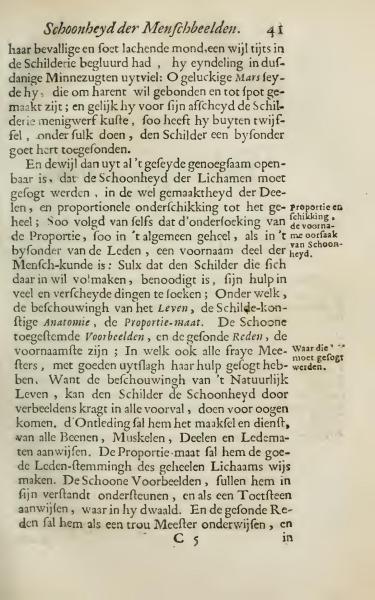 | This text discusses the beauty of human figures and their representation in art. It emphasizes the importance of studying proportions, anatomy, and the overall structure of the body for artists. The study of life, anatomy, and examples from masters guide artists in accurately depicting human forms. |
| Goeree - Natural Design - Page 59 |  | This passage discusses the idea that God created everything with measure, weight, and number, including the human body as one of the most artful and perfect creations. The text emphasizes the proportional harmony and architectural significance of the human form, likening it to sacred structures like Noah's Ark and the Temple of Solomon. It also suggests that the various measures used in construction are derived from the human body. |
| Goeree - Natural Design - Page 60 |  | The text discusses the ideals of human figure composition, stressing that limbs of unequal gender or age should not be combined, except in anomalies. It explores the concept of beauty in Adam and Eve's proportions, and highlights the importance of accurate limb alignment and proportions, which have been valued since ancient times. |
| Goeree - Natural Design - Page 61 |  | The text discusses the importance of understanding precise proportion in creating harmonious human figures in art. It explains how two artists, Telekles and Theodorus, managed to create a unified statue despite working separately, emphasizing the need for a precise grasp of proportion. The text advises focusing on essential exercises to understand proportions without overcomplicating the process. |
| Goeree - Natural Design - Page 62 |  | The text discusses the challenges in defining and maintaining rules for drawing human figures, emphasizing the importance of understanding natural variability over strict mathematical proportions. It highlights the influence of artists like Albert Dürer in illustrating countless human positions and movements. The author warns against trying to fit diverse human forms into rigid molds, suggesting that such attempts lead to errors in art and creative stagnation. |
| Goeree - Natural Design - Page 63 |  | The text elaborates on the natural differences in human body proportions, affecting individuals' abilities to perform different actions. It discusses how specific physical attributes, like broad shoulders or long fingers, can influence skill in tasks such as weight-bearing or playing instruments. The text advises that children start practicing early to develop necessary physical flexibility and strength for arts like wrestling or tumbling. |
| Goeree - Natural Design - Page 64 |  | This text discusses the importance of accurately portraying the alignment of limbs and the overall posture in human figures. It emphasizes that the more precisely these aspects are observed, the more excellence can be achieved in painting. The text contrasts properly proportioned figures with those that appear weak or improperly rendered, stressing the importance of realistic and convincing depictions. |
| Goeree - Natural Design - Page 65 |  | The text discusses the importance of understanding proper proportions in human figures to judge the health and convey accurate depictions in art. Leonardo da Vinci emphasized focusing on the length of figures, allowing nature to dictate other dimensions harmoniously. Artists are advised to follow these natural proportions to ensure vibrant and correct representations. |
| Goeree - Natural Design - Page 66 |  | This text discusses the concept of proportion in human figures, noting that some bodies naturally or accidentally deviate from common proportions but maintain a better harmony of limbs. It contrasts well-proportioned examples like giants with dwarfs and deformed people, who lack such harmony. The author references Athanasius Kircher's works for further tales of giants and explains these extremes cannot be aligned with human functionality. |
| Goeree - Natural Design - Page 67 |  | The text discusses how human limbs function without overwhelmingly feeling their weight due to their connection to the whole body. It contrasts smaller and larger beings, using Roman soldiers as an example to demonstrate that familiarity with weight, such as carrying weapons, reduces the perceived burden. The piece also notes a natural difference in height between men and women. |
| Goeree - Natural Design - Page 68 |  | The text discusses how the climate in which people are raised influences their physical and behavioral characteristics, often leading to region-specific traits. It describes how different nationalities express unique qualities through their appearance, demeanor, and actions. Specifically, it praises the Dutch for their flexibility in adopting the best traits from various regions, and notes the reliability of Dutch people as reflected in a common saying about their trustworthiness. |
| Goeree - Natural Design - Page 69 |  | This text offers a depiction of certain European national characteristics during the era. It notes that Germans are generally taller, loyal, and brave, while being slow to deliberate and sometimes sly. Englishmen are described as open-minded yet indecisive, with a tendency to be distrustful in business, gluttonous, and outwardly religious, while often being sickly. |
| Goeree - Natural Design - Page 70 |  | This text describes the stereotypical characteristics of people from France, Italy, and Spain. A Frenchman is depicted as skillful and sociable but fickle in loyalty. An Italian is portrayed as shrewd and modest but fiercely loyal, while a Spaniard is characterized as deceitful yet brave. Each nationality is described with various traits and behaviors. |
| Goeree - Natural Design - Page 71 |  | The text humorously discusses stereotypes about different nations, attributing characteristics to them based on an anecdote about Lucifer's fall from Heaven. Different body parts fell in different countries, leading to particular traits. It concludes that diverse characteristics in people are influenced by their environment and birth conditions. |
| Goeree - Natural Design - Page 72 |  | The text discusses the ways in which people show different behaviors due to air, physical influences, and situations, causing varied expressions and reactions in society. It explores how different circumstances, such as metaphorical winds or wine consumption, impact one's demeanor, leading to diverse exhibitions such as joy, sadness, or quarrels. The text comments on characteristic human behaviors, pondering how seemingly trivial things can provoke significant differences in responses among individuals. |
| Goeree - Natural Design - Page 73 |  | The text discusses how different stages of life, such as childhood and adulthood, display distinct physical proportions in humans. It highlights how these proportions change and how disorders can affect them. The passage also notes historical observations on human life expectancy and how it is reflected in ancient writings and beliefs. |
| Goeree - Natural Design - Page 74 |  | The text describes human age divided into nine stages, each spanning seven years, noting changes in proportion, strength, and movement. It discusses various life stages such as childhood, adolescence, youth, and old age, compared metaphorically to the seasons. Hippocrates' view segments life into four stages akin to spring, summer, autumn, and winter, highlighting their qualities. |
| Goeree - Natural Design - Page 75 |  | The text discusses the division of a person's life into ten-year segments, suggesting an ideal lifespan of 100 years, with analogous proverbs about age and wisdom. It also outlines the ideal proportions of a well-proportioned human, emphasizing six-foot measurements and using the head as a unit of proportion similar to architectural modulus. It notes common practices in drawing and sculpture regarding human proportions. |
| Goeree - Natural Design - Page 76 |  | The text discusses the concept of proportion in human figures, comparing the flexibility needed in art to the dexterity of a snake or a thief. It warns against strictly adhering to traditional measurement rules, noting that great masters demonstrate variety. The main takeaway is that proportion guidelines serve as a foundation rather than an absolute rule in artistic representation. |
| Goeree - Natural Design - Page 77 |  | The text discusses the ability to achieve well-proportioned bodies through established rules derived from nature's examples. It mentions that different proportions can be equally impeccable, using a unit of heads to describe the proportions of human figures. The text references Albert Dürer and emphasizes the importance of precise measurement balanced with the natural development of skill through practice. |
| Goeree - Natural Design - Page 78 |  | The text discusses how the proper proportions of human figures in art can often be judged by eye without extensive measurement, focusing on the head as a key indicator. It explains how a large head can make a body seem smaller, while a small head can make it appear larger, affecting the overall perception of a sculpture's greatness and dignity. The passage also notes a historical tendency among sculptors to use smaller heads to enhance the perceived grandeur of their works. |
| Goeree - Natural Design - Page 79 | 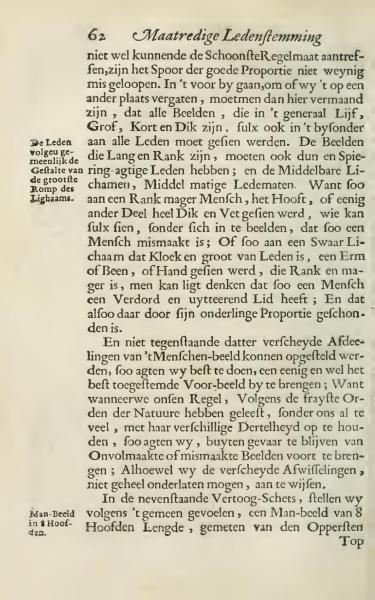 | The text discusses the importance of achieving proportional harmony in depictions of the human body. It highlights how figures should have consistent proportions across their body parts to avoid appearing imbalanced. The text also emphasizes adherence to natural rules of beauty to prevent creating incomplete or misshaped figures. |
| Goeree - Natural Design - Page 80 |  | This page, titled 'The Human Figures,' features a drawing labelled as 'Male Figure of 8 Heads.' The text and illustration together focus on the representation of human proportion where the body is conceptualized in terms of head units. |
| Goeree - Natural Design - Page 81 | 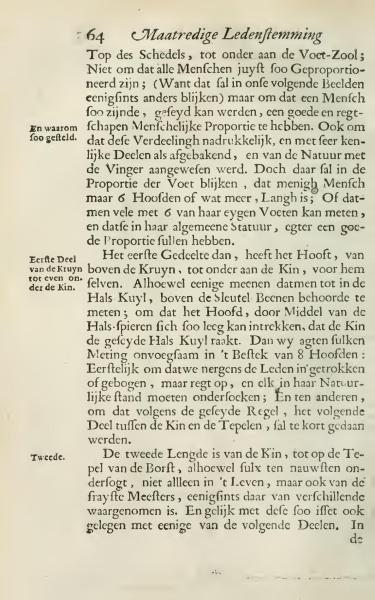 | The text discusses human body proportions, particularly the relationship between various parts from the head to the foot. It argues for a system where general body proportions can be measured in heads or feet. It warns against certain measurement methods that alter natural states and highlights proportional techniques used by masters. |
| Goeree - Natural Design - Page 82 |  | The text discusses the proportions of the human figure, particularly focusing on the measurements from the nipples to the navel and from the navel to the pubic area or the lower abdomen. It notes how Vitruvius and others have considered these measurements in creating a circle that encompasses the human figure with outstretched limbs. The text also explains Aristotle's views on proportions indicating health and vitality. |
| Goeree - Natural Design - Page 83 |  | Saul's physical beauty and height are highlighted in the scriptures as qualities fitting of a king, as noted by the Prophet Samuel. This emphasis on physical attributes is historically rooted in both barbarian and virtuous cultures, with Aristotle observing that those with exceptional bodies are suited for greatness. The text reflects on how physical beauty is often considered superior, despite the greater importance placed on the virtues of the mind and spirit. Mayor Marius is mentioned for his discernment in selecting young soldiers based on these ideals. |
| Goeree - Natural Design - Page 84 |  | The text describes historical measurements and representations of human figures used in assessments of suitability for soldiering roles, referencing Roman depictions. These figures were generally depicted as sturdy, not overly tall, but proportional. It details specific measurements of the body such as the lengths from the abdomen to the knee, down to the foot, highlighting ancient methods of depicting soldiers. |
| Goeree - Natural Design - Page 85 | 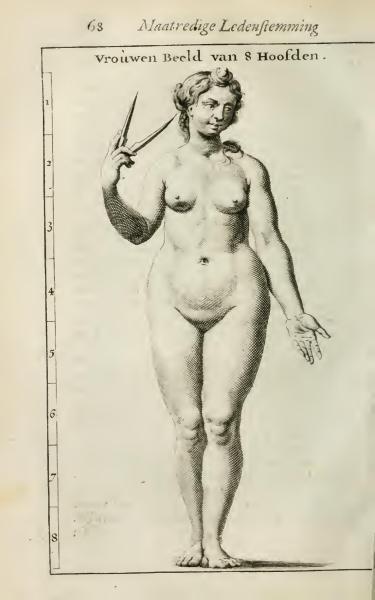 | The text describes a study of human proportions, focusing on a female figure measured in a classical '8 head' method. This method divides the body into eight sections based on the height of the head. The image complements this exploration by illustrating these proportions with a detailed drawing. |
| Goeree - Natural Design - Page 86 |  | The text discusses the proportional comparison of male and female figures in art, explaining that while the general length is considered equal, women should be depicted as slightly shorter to prevent them from appearing bulky. It notes specific differences in body structure, including broader hips in women and broader shoulders in men. The text also mentions that broad-shouldered women were often seen as fertile by some historical scholars. |
| Goeree - Natural Design - Page 87 |  | The text elaborates on the proportional measurements of the human figure, drawing on Leonardo da Vinci's belief that a figure should be divided into 10 parts of faces or profiles for proportion. It discusses how women's heads are generally smaller than men's and the influence of hairstyles on perceived head size. It also notes the ancient practice of dividing statues into parts, highlighting how this has changed over time. |
| Goeree - Natural Design - Page 88 |  | The text describes the division of the human body into 15 parts, detailing measurements from the head to the foot. It references Jan Pol Lomazzo's book on human proportion and mentions comparisons to horse anatomy. The text also highlights proportions derived from Leonardo da Vinci's teachings. |
| Goeree - Natural Design - Page 89 | 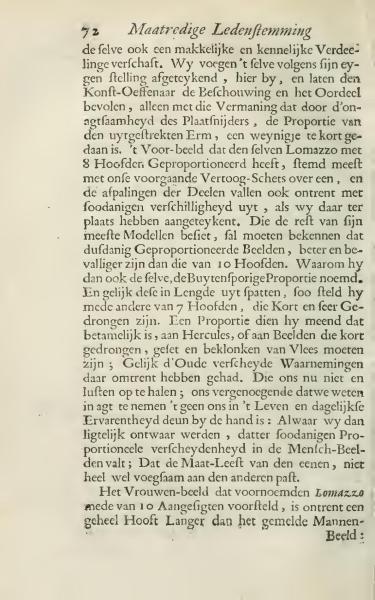 | The text discusses the proportions of the human body in artistic representation, emphasizing the use of different units like "heads" to measure and compare body parts. Lomazzo's method of proportioning figures to 8 heads is considered superior to using 10 heads, which can result in figures that are less aesthetically pleasing. The discussion includes various observations about how different body proportions relate to traditional artistic standards and notable examples, like those resembling the figure of Hercules. |
| Goeree - Natural Design - Page 90 |  | The image presents concepts of human figure proportions as outlined by Lomazzo. It includes a male figure segmented into seven and a half heads, indicating detailed study and emphasis on classical human proportion. The text describes the illustration of a human figure and its proportional guidelines. |
| Goeree - Natural Design - Page 91 |  | The text discusses the measured proportions in art, particularly focusing on male and female figures. It describes how the female figure can be depicted with 9 views compared to the male's 10, and elaborates on the historical context with references to antique beliefs about Goddess Vesta's proportions. The idea of artistic refinement for young learners is also mentioned with a reference to Lomazzo's views. |
| Goeree - Natural Design - Page 92 |  | The text provides an illustration of female human proportions based on the teachings of Lomazzo, focusing on a measurement from head to toe equating to seven and a half heads. It serves as a guide for artists studying human anatomy. This method of using heads as a measure is a classical technique in figure drawing. |
| Goeree - Natural Design - Page 93 |  | The text discusses the differences in the upbringing of boys and girls, noting how these differences lead to men being physically stronger and bolder than women. It mentions that boys engage in more physical activities, which helps in developing their strength and character, whereas girls are traditionally kept closer to their mothers and partake in quieter activities. The text uses a proverb to illustrate the impact of proportion on elegance in depictions. |
| Goeree - Natural Design - Page 94 |  | The text discusses how boys engage in various playful activities that are structured with rules and observations. These activities subtly train them for productive occupations in adulthood by transitioning from play to handling practical tasks. Such exercises foster physical strength and a bold spirit, preparing them to become responsible adults with naturally inclined skills. |
| Goeree - Natural Design - Page 95 |  | The text discusses Mr. Ruysse's decision to return his nephew from art to warfare, indicating the boy's lack of progress in art. It emphasizes the importance of maintaining threefold proportions in art, ensuring harmony among natural proportions, well-being, and gracefulness. When natural order fails, adaptations must be made carefully to not disturb the balance. |
| Goeree - Natural Design - Page 96 |  | The text discusses the virtue of actions and how they captivate viewers, quoting Albertus Durer on the value of necessity. It highlights that in children's growth, strict adherence to adult proportions is unnecessary because the focus is primarily on the upper body parts during early development. It explains the divisions of the body into different segments, particularly for children, indicating that children's body proportions differ from adults as they grow. |
| Goeree - Natural Design - Page 97 |  | The text discusses the concept of body proportions, emphasizing that children at the age of three have half of their expected adult height. It explains commonly misunderstood concepts of proportional measurement, including how physical features might grow in relation to each other. The work references ideas from Lomazzo regarding the staging of children's development using units of heads. |
| Goeree - Natural Design - Page 98 |  | |
| Goeree - Natural Design - Page 99 |  | The page provides illustrations and measurements of childlike proportions, detailing how the head size relates to the overall body. These diagrams serve as an educational reference for artists to understand and accurately render child anatomy in art and sculpture. |
| Goeree - Natural Design - Page 100 |  | The text describes the proportions of human figures, particularly between children and adults, noting differences in proportion related to head sizes and body dimensions. It elaborates on how these proportions align more with male figures and explains the variability in features like the nose, mouth, and chin. Additionally, it discusses the growth process in living beings, emphasizing the role of vessels, veins, and intake of new food in physical development. |
COPYRIGHT © 2024 STUDY DRAWING. ALL RIGHTS RESERVED.